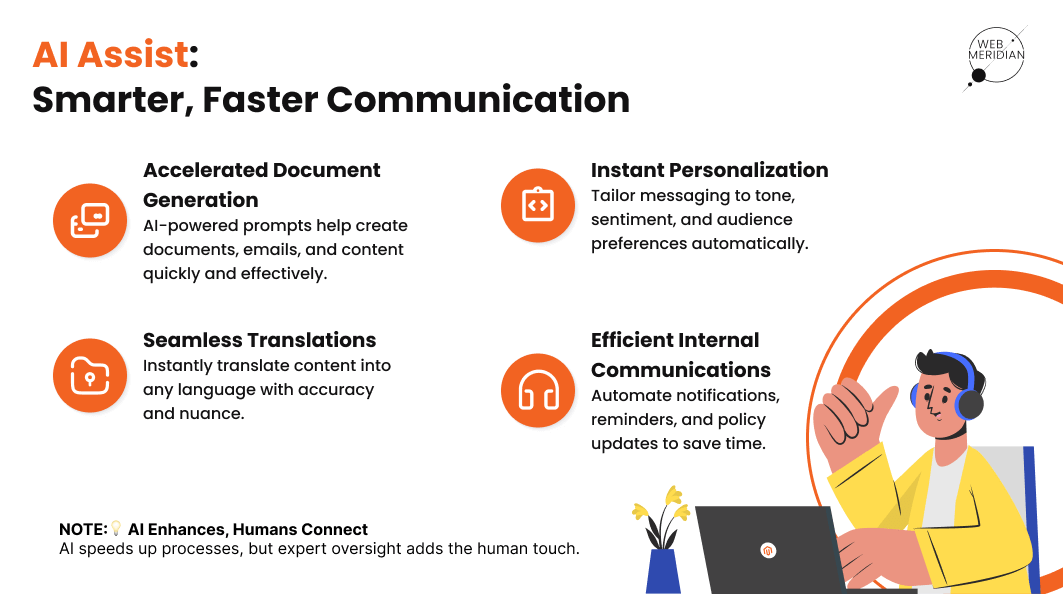Last year a communication training was held in our company, which became an advantageous experience for all participants. So, we came up with the idea to write a small article about communications in an IT company and the specifics of communications with customers from worldwide based on our knowledge.
- How AI Has Enhanced the Role of IT in Communication in 2025
- What Is Business Communication and Cross-Cultural Communication?
- Basic Business Communication Skills in the IT Field
- STEPS – An Effective Communication Pattern for Business Communication
- Drawing up a Communication Plan at the Beginning of the Project
- Tips for Cross-Cultural Communication
- Peculiarities of Remote Communication (By Email, Video Communication, Messengers)
- Communication With Colleagues in New Realities
- To Sum Up
Boost Your Conversions with Expert CRO Consultants!
Driving traffic to your website is only half of the way. The visitors’ further trip through your sales funnel determines your revenues. Talk to our conversion rate optimization consultants to understand the potential areas that may hinder the consumer path, and let’s refine it together for greater conversions.

How AI Has Enhanced the Role of IT in Communication in 2025
Artificial intelligence reinvents business communication with such progressive technologies as natural language processing, real-time translation, and chatbots. By spurring efficiency, personalization, and accessibility, intelligent solutions connect people across borders and cultures. Let’s explore several fascinating AI-empowered IT tools and how they reshape the role of it in communication.
Chatbots and virtual assistants
In 2025, intelligent chatbots and virtual assistants are becoming considerably more human-like. Leveraging advanced natural language processing (NLP) and machine learning, they deliver meaningful conversations, addressing numerous questions and providing consistent advice. Round-the-clock support, personalized assistance, and voice interaction are their fundamental functionalities.
Examples:
- Chat GPT (by OpenAI). ChatGPT is designed for natural conversation, content creation, and problem-solving. Thanks to deep learning mechanisms, the tool can interact like a human and play a significant role in customer support, brainstorming, and automation.
- Google Bard. Google Bard leverages Google’s PaLM 2 model to provide real-time, actual responses. It accesses the internet for the most relevant information. Therefore, the tool is perfect for research and content generation.
- IBM Watson Assistant. Targeted at large enterprises, it can deal with complex queries, integrate with CRM systems, and provide multi-channel support.
Automated real-time translation for effective business communication
The role of international communication in business is hard to overestimate. AI-backed translation technology removes language barriers and makes global communication effortless. Modern neural machine translation (NMT) systems ensure precise and smart translations, including text, voice, and video.
Examples:
- DeepL Translator. A powerful and accurate AI-enabled tool, DeepL considers the context and ensures exceptional relevance in its translations.
- Microsoft Teams. A solution for virtual meetings, Microsoft Teams provides live captions and translations, enabling participants to see subtitles in their chosen language.
- Zoom Live Translations. The tool supports video conferences with live translations in multiple languages.
Discover How AI Can Automate Your Business and Boost Your Profits
AI has the transformative power to drive your business ahead of the competition. Make AI integrated competently into your operational processes, and it will work in your favor. Our team will help you harness breakthrough tools and AI models to automate part of your tasks and enhance overall efficiency.

Intelligent IT solutions for email and messaging
The role of it in communication also spans written interactions. Thus, AI transforms email and messaging systems, bringing written communication to a new level. Such features as smart email filtering, automated responses, grammar and style enhancement, and fraud detection make interactions easier and more comfortable.
- Google Smart Compose & Smart Reply. These features are integrated into Gmail. They help users by suggesting full sentences and quick replies, maintaining efficient discussion, natural tone, and coherence.
- Drift Email. Designed to automate numerous lead-generation processes, this tool analyzes incoming emails and directs them to the appropriate teams for response.
- Phrasee. Employs predictive algorithms to compose email subject lines and marketing texts, which propel open rates and engagement.
AI-enabled sentiment analysis
Sentiment analysis is a new business communication function where AI can deliver valuable results. Intelligent technology analyzes text and voice interactions, detects consumer emotions, and empowers businesses to optimize responses, reinforcing the role of communication and strengthening brand reputation.
- MonkeyLearn. By utilizing machine learning, the tool examines customer feedback, emails, and social media interactions to differentiate positive, negative, or neutral sentiments. This helps companies elevate user experience.
- Amazon Comprehend. Identifies sentiment in emails, chats, and surveys, helping customer service teams improve responses and delight consumers.
The recent years mark the evolution of IT’s role in communication from a supportive tool to a powerful driver of business efficiency. Backed by artificial intelligence, IT solutions acquire amazing features and enhance smooth, personalized, and conducive interactions across languages and platforms.
Boost Your Online Business With Our Expert eCommerce solutions
Get in touch to see how WebMeridian’s custom eCommerce solutions can elevate your store, increase traffic, and drive sales.

Communication is one of the essential parts of a person’s private and professional life. Basically, it’s a process of informational exchange between two or more people; communication can be held with the help of verbal and non-verbal methods and is aimed at transferring and receiving some information.
Effective communication with the client raises his/her loyalty and helps to understand the business necessities better. It’s crucial to set up communications between all team members because the success of a project enormously depends on it. Usually, a project manager is responsible for setting up the communication process and is highly involved in all types of communications within the project.
Obviously, cross-cultural communication presupposes communication between the representatives of different cultures. Usually, it’s not enough only to know a foreign language well, and it’s also necessary to understand the mentality and picture of the client’s world.
For example, it’s well known that communication with top management is free and more democratic in American society than in the “countries of late democracy”. This peculiarity was brought to the Ukrainian IT community, where the so-called “open door policy” is widely spread.
What Is Business Communication and Cross-Cultural Communication?
The basic communication skills include:
- Active listening means concentration, understanding, remembering and critical analysis; these skills will help in the client’s requirements gathering in the presale phase, receiving feedback from a client and communicating with the team.
- Literate speaking and writing; nowhere without these skills will help in conflict resolution, and in general, it’s always good to be able to express your thoughts clearly. It’s a highly crucial skill for eCommerce consulting specialists.
- Holding presentations; It’s an essential skill for sales managers in negotiations and project managers while having a demo day.
- Sales; Basically, the ability to present the value of a solution lies in the foundation of any potential partnership.
- Networking is a handy skill for all in IT and not only. It helps to expand your circle of acquaintances, share your experience and grasp other people’s knowledge.
All these skills will be helpful in business communication with customers from any country and within the company with colleagues.

Basic Business Communication Skills in the IT Field
You can take into account the following pattern of effective communication:
S (space) – this is the concept of personal space in which a person feels comfortable interacting with different people.
T (take turns) is a rule that requires speaking in turn because communication is an equal process in which everyone should be able to express themselves.
E (eye contact) – the need to establish eye contact promotes effective communication. After all, this is how we not only show respect for a person but also have the opportunity to observe his facial expressions and understand his emotions.
P (polite) is an extremely attractive, friendly, open communication style. Everyone likes to communicate with polite people and establish friendly relations.
S (staying on topic) requires sticking to the topic (not changing it) while the discussion continues.
STEPS – An Effective Communication Pattern for Business Communication
And now, a few words about communication management. It will be advantageous to draw up a communications plan at the project planning stage. To begin with, it is worth defining the roles of interested parties and making a similar table:

Then it is worth agreeing with the interested parties on the following table:

Thus, we get a complete picture of who our stakeholders are, how, when and what we will communicate with them during the project implementation.
Drawing up a Communication Plan at the Beginning of the Project
- Etiquette. When Americans quickly switch to a first-name address, Germans, for example, are more inclined to use formal addresses. It would be best if you never forgot these peculiarities so as not to offend the interlocutor. It is always appropriate to ask, “How are you?” to start a conversation, that is, to begin with, small talk.
- Slang and phraseology. Be cautious about using slang with business partners. It changes quickly and loses relevance, so it is easy to use an outdated informal phrase. And slang is only partially appropriate in business communication. It is better to say “I agree” to the client than “You betcha” and, for example, “Please wait.” than “Hold on a sec.” Do you agree? Phraseological units are appropriate only if you know their exact translation; some have several meanings in English, and you need clarification.
- It is worth working on diction and pronunciation. Speak a little slower so that everyone will understand you, and try to divide sentences into short ones, avoiding long turns. The correct pronunciation is also crucial. The most common mistake is the ending “ed” in verbs, which is muted and pronounced as “t” instead of “ed”.
- It’s a good practice to take notes when the client explains the essence of the task for a long period of time, and be sure to ask, “Do I understand correctly that …” if something is unclear. It is better to ask again immediately than to give the task to the team incorrectly.
- Closed questions that can be answered with “yes” or “no” should be avoided. It is better to prepare a list of open questions so that you will get more information about the project.
- It’s better to be careful with jokes on controversial topics. Use jokes in cases when you’re sure it’s appropriate.
- It’s also better to avoid abbreviating names during communication with customers. For a foreigner, the names Mikhail and Misha sound and can be interpreted differently, as if they are 2 people. It is better to choose one spelling and stick to it. Sometimes it is more convenient for customers to pronounce and write the name in their own way so that Iryna can become Irene or Kateryna – Kate.
Tips for Cross-Cultural Communication
Response Time
Different companies may have other email response times. At WebMeridian, response within an hour is considered a good tone. Remember that if you go on vacation or have a day off, you can set up an auto-reply to incoming emails.
Statuses That Make Life Easier
Remember that if you communicate in corporate messengers such as Slack, you should respond to messages faster. Statuses such as “On vacation”, “At a meeting”, “At lunch” come in handy here. This will indicate that you can wait longer for an answer.
Chats That Solve Questions in a Minute
The communication policy in companies varies, but in channels like “general” it is very convenient to use threads to reply to a message. This structures the overall chat and does not create chaos in the messages. This is exactly the approach we are introducing at WebMeridian.
Video Calls and Nuances
If you need to make a video call but work from home, it’s better to take care of a more or less appropriate background, or you can always set a background from those offered by video conferencing platforms. If a call is planned where the client will explain the details of the task, it may be useful to record it. In this case, it is necessary to ask whether the interlocutor is not against it.
Also, after the call, it’s a good practice to send an email with the main points that were discussed and what conclusions were reached, and if there are any questions, then they should also be written separately.
If there are a lot of people present at the video conference, such a function as “raise your hand” will come in handy. It will become clear to the person conducting the call that someone wants to speak and give him the floor.
Peculiarities of Remote Communication (By Email, Video Communication, Messengers)
In this challenging time for all of us, we need to support each other, remembering how crucial effective communication is.
- It is always a good idea to ask if your colleague is safe.
- It is worth considering blackouts and mobile internet problems; it’s good to warn your colleagues and the team about it.
- If possible, use the time off to reboot your mental strength.
- It is worth limiting informational noise in the form of news, reviews, etc., to the necessary minimum.
- Apply emotional intelligence and empathy in communication with colleagues.
- Describe tasks and messages as clearly as possible.
- Keep the primary goal of the collaboration in focus.
Communication With Colleagues in New Realities
Let’s note that every company should have its own defined communication policy, both with customers and colleagues. Without it, many problems arise, such as wasted time and money, destructive code, missed deadlines, and products that don’t meet customer expectations. Therefore, effective communication is one factor in the company’s success.



